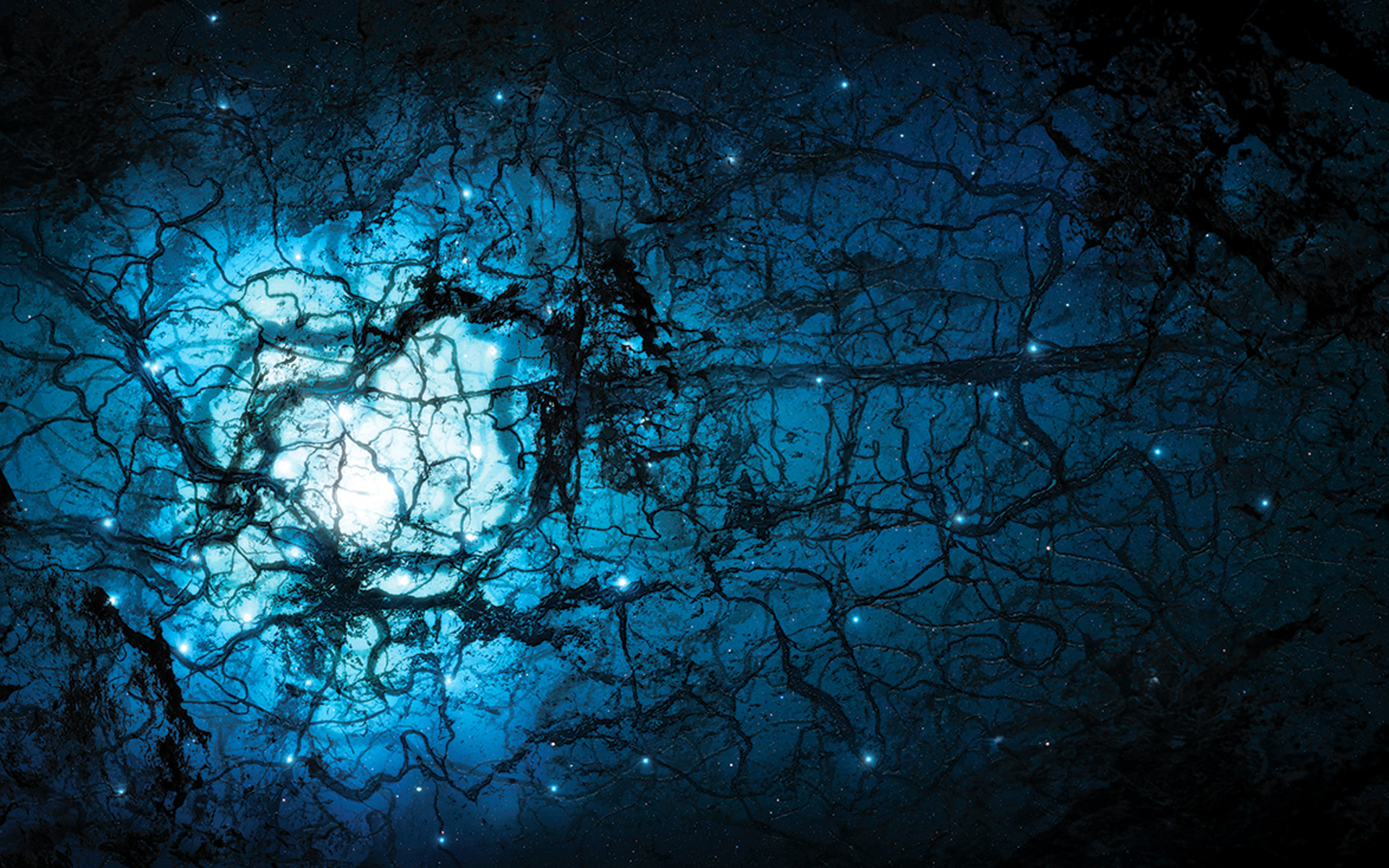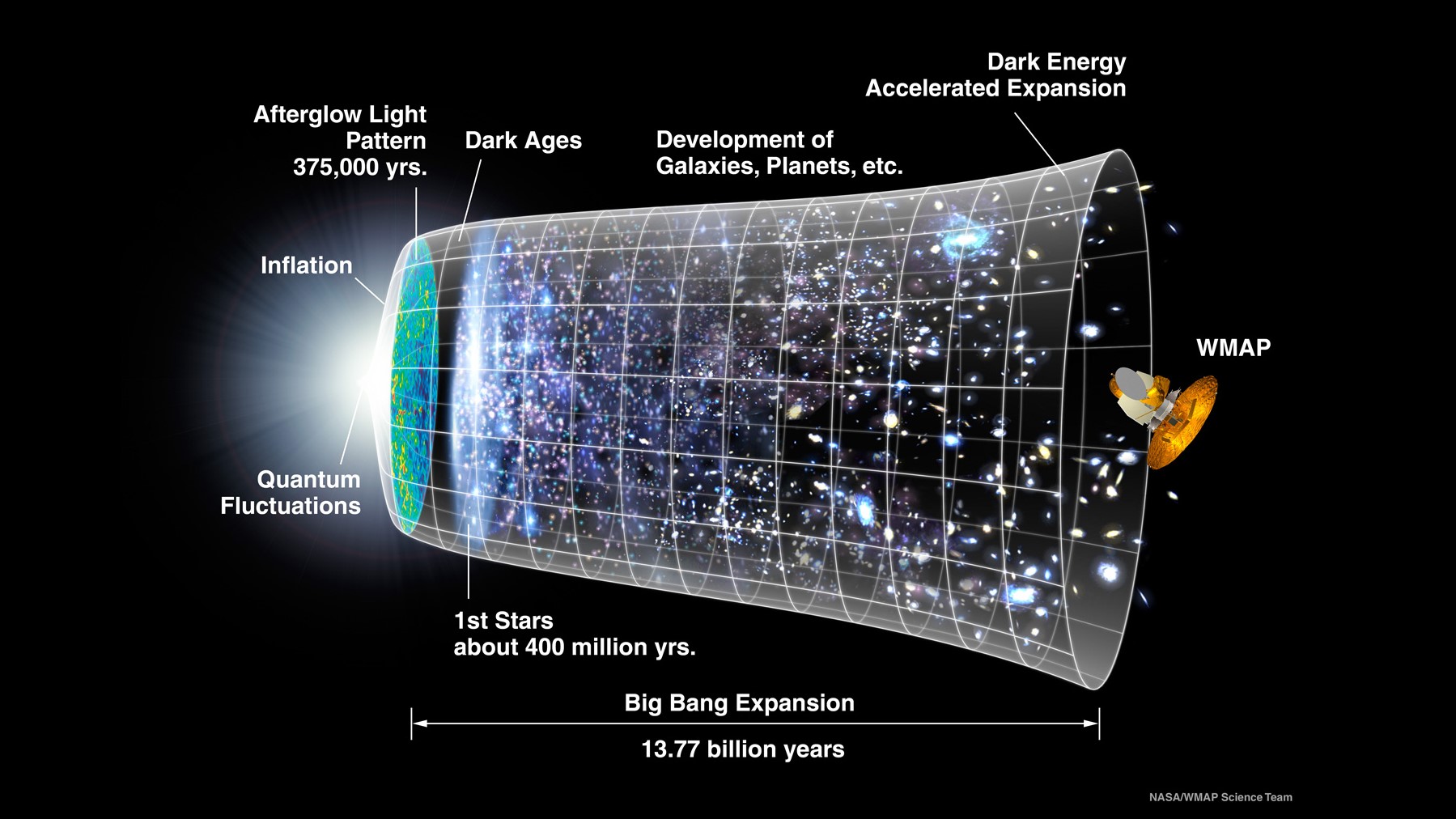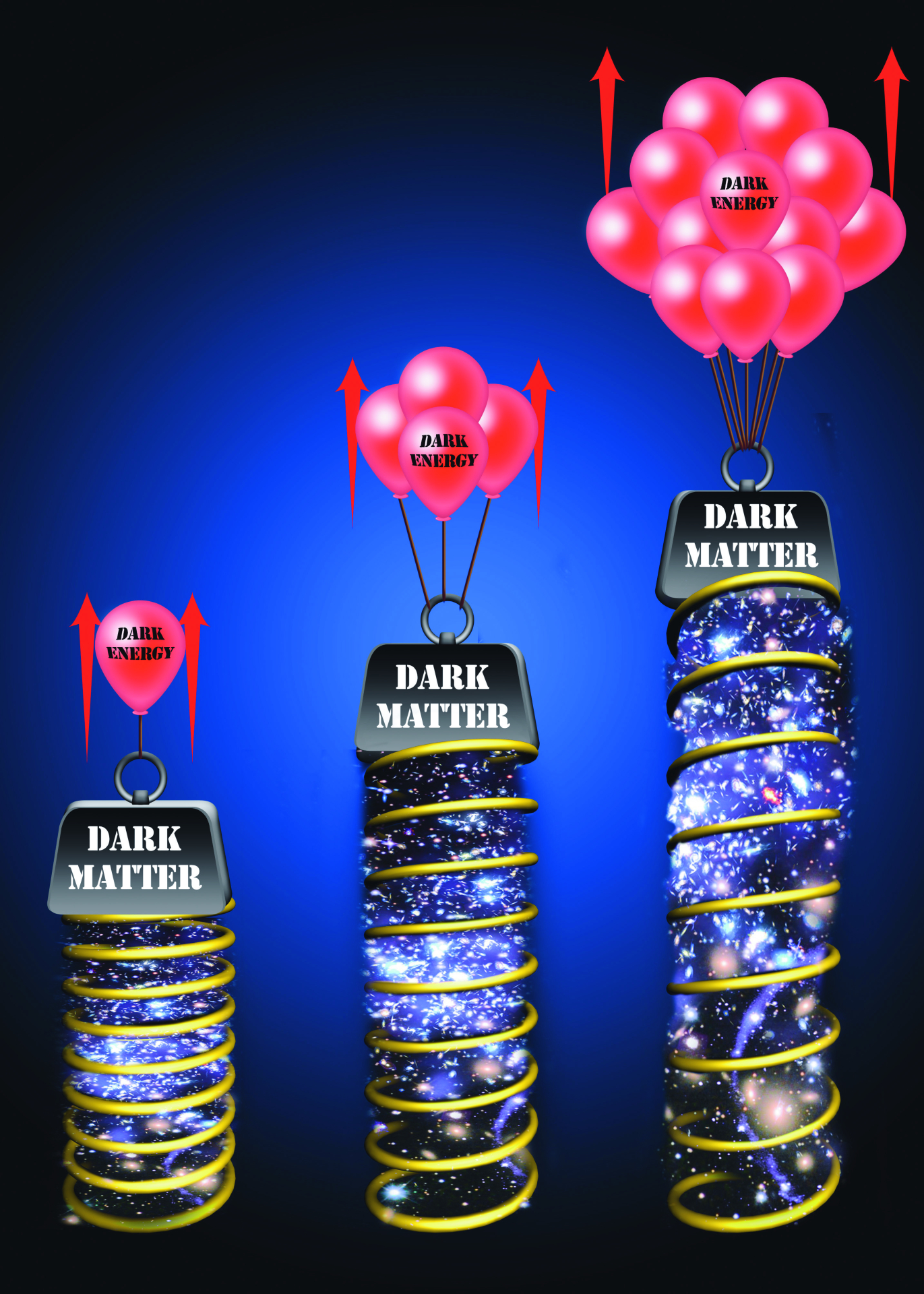What is dark energy?
The dominating form of energy in the cosmos, dark energy is driving the accelerating expansion of the universe, but its nature remains a complete mystery.

Dark energy is a hypothetical form of energy that is proposed by physicists to explain why the universe is not just expanding but is doing so at an accelerating rate.
Think of dark energy as the "evil counterpart" to gravity–an "anti-gravity" force providing a negative pressure that fills the universe and stretches the very fabric of spacetime. As it does so dark energy drives cosmic objects apart at an increasingly rapid rate rather than drawing them together as gravity does.
Dark energy is estimated to account for between around 68% to 72% of the universe's total energy and matter — its matter/energy budget — meaning it heavily dominates both dark matter and everyday matter.
Related: Do parallel universes exist? We might live in a multiverse.
The only real answer to the question "what is dark energy?" currently is "we don't know" as unsatisfactory as that may be. Scientists aren't completely in the dark, however. There are some leading candidates to account for dark energy.
These include the vacuum energy of space — particles literally popping in and out of existence in empty space — and a "fifth force" responsible for the negative pressure that might cause the accelerated expansion of the universe.
Other possibilities a range of different "flavors" of fields that could account for dark energy such as a low-energy field dubbed "quintessence," fields of tachyons — hypothetical particles that travel faster than light and thus back in time — among other concepts.
Breaking space news, the latest updates on rocket launches, skywatching events and more!
All of these remain purely hypothetical meaning that the only way we can really "know" dark energy currently is via its effect on the universe.
Dark energy expert Q&A
We asked Luz Ángela García, a cosmology postdoc in Bogotá, Colombia, a few questions about dark energy.

Luz Ángela García is a cosmology postdoctoral researcher at Universidad ECCI in Bogotá, Colombia.
Why is dark energy a necessary part of the universe?
About 25 years ago, it was established that the Universe is expanding, and such expansion is speeding up with time. This process has been occurring for the last 5,000 million years, and it causes galaxies to recede from others. Although all our cosmological observations back up this phenomenon, we still don't have an explanation for this trend in the expansion. However, we do know the properties of the ingredient that causes this effect: it has to be a substance or fluid that overcomes the attractive nature of gravity, and it has to be diluted and spread in all space-time.
In 1999, the physicist Michael Turner named that hypothetical ingredient of the cosmological budget: dark energy. The latter is necessary to provide a plausible explanation for the current trend in the Universe's expansion. Without it, the expansion would slow down, and eventually, the Universe would have imploded, shrinking the distance between observed galaxies in the large-scale structure.
How do we know the expansion driven by dark energy isn't just connected to the Big Bang?
Well, our cosmological model predicts an expanding universe, and as a consequence, the existence of an event that we call Hot Big Bang. Yet, the current state of the expansion is not constant in time, instead is increasing; thus this growing rate in the expansion has to be driven by a different factor, something that wasn't predominantly acting during the early stages of the Universe or at times where galaxies formed.
Why is dark energy so mysterious?
Because we can't measure it directly, we don't even know what it is made of, then formulating experiments to detect it and study its very nature is really challenging. Also, current observations disagree with the value of the Hubble rate at the present time, therefore, we are uncertain if dark energy is changing in time, and if so, how it is affecting the dynamics of the expansion. We have clues, but there is still a long path to go before "unveiling" dark energy's nature and traits.
What are the main suspects for dark energy?
According to the vast majority of observations, the most likely candidate for dark energy is the cosmological constant, often related to the fluctuations of the quantum vacuum. It is the preferred (and most simple) explanation for dark energy, to the point that is included in the standard cosmological model. But there are other proposals, such as scalar fields, galileons, axions, tachyonic fields, or even dynamical dark energy models, among many other ideas.
Will the dark energy mystery be solved in the next 10 years?
It's hard to anticipate if we will solve the mysterious composition of dark energy in such a short period (most international projects last about that time frame), but I am positive we are going in the right direction to understand this component of the cosmic budget, no less than 70% of the ingredients of our Universe. Telescopes like DES, DESI, Euclid, JWST, the Vera Rubin Observatory, and Nancy Grace Roman intend to decipher dark energy's nature and evolution through time by tracing the large-scale structure and measuring with different techniques the Hubble constant. There is a wealth of data that will guide us in this journey, and for sure, we are making progress in understanding what dark energy is and its cosmic origin.
What dark energy does (and doesn't) do?
If dark energy is causing the universe to expand at an accelerating rate, shouldn't we see our coffee mug shift away from us or notice our commute to work getting longer each day?
We don't see things like this happen (even though it may feel like we do sometimes) because objects that are gravitationally bound such as stars, planetary systems, star clusters, galaxies, clusters of galaxies, and even our coffee mug and table, don't seem to experience dark energy's effects. Gravity still beats dark energy at small scales.
Dark energy only seems to act on the largest scales of the universe, with the expansion of the universe a phenomenon that can only be measured by observing galaxies and other cosmic objects that are separated by massive gulfs of space in the order of millions, billions, and even tens of billions of light-years apart and away from us. And the greater the distance that separates these cosmic objects, the more rapidly they race away from each other.
As a simple analogy for this, imagine drawing three spots on a deflated balloon, two close together and the other further apart. In this analogy, dark energy is the breath blowing into the balloon overcoming gravity which is represented by the tension of the balloon's rubber skin. As the balloon is inflated all three points will move away from each other, but the furthest point will move away more rapidly.
This is like three galaxies, two close together and the other further apart, the latter of which is moving away faster because the space between it and the other galaxies, like the rubber of the balloon, is stretching, and more space means more expansion.
Currently, scientists estimate that galaxies are getting 0.007% further away from each other every million years. American theoretical astrophysicist Ethan Siegel explained in a column for Big Think that in "real terms" for a cosmic object 100 million light-years away astronomers infer it is receding at 1,336 miles per second (2,150 kilometers per second). Meanwhile, a galaxy 1 billion light-years away is receding 10 times faster at around 13,360 miles per second (21,500 km/s).
The rate of expansion has been measured for the galaxy Galaxy GN-z11, one of the oldest galaxies ever discovered which we see as it was when the universe was just 400 million years old. An estimated 32 billion light-years away, dark energy is expanding the fabric of space at such a rate that GN-z11 is moving away from us at an estimated speed of 426,882 miles per second (687,000 km/s) — over twice the speed of light.
While it's true that nothing can travel through space faster than the speed of light in a vacuum, 186,282 miles per second (299,792 km/s), dark energy demonstrates that the fabric space itself is not bound by such speed limits.
As they separate out, galaxies retain their shape and don't spread apart internally thanks to another 'dark' aspect of the universe — dark matter.
Don't be fooled by the similar names, dark energy and dark matter — sometimes grouped together and described as the "dark universe"' — aren't believed to be related aside from a few superficial similarities.
Dark energy vs dark matter: What's the difference?
Both "dark" aspects of the universe are mysterious and have thus far defied explanation, and both can't be directly detected with their existence inferred by the effect they have on visible matter. But, it's incorrect to think of dark energy as simply the energy equivalent of dark matter.
Dark matter doesn't interact with light as does matter composed of atoms made of protons and neutrons, part of the baryon family of particles, that surrounds us every day and is known as "baryonic matter."
Dark matter is, therefore literally "'dark" and thus the prefix in "dark matter" is used more literally than used in "dark energy" rather than just alluding to a mysterious nature alone.
The main way we know dark matter exists is from its gravitational effect of holding galaxies together. Without the gravitational influence of dark matter, galaxies are swirling so rapidly that the gravitational influence of their visible matter — stars, planets, gas, and dust — would be insufficient to prevent them from flying apart.
That means as dark energy is pushing things apart on a large scale, dark matter is holding galaxies together on a smaller scale. In that respect, dark energy and dark matter could almost be considered as having opposite effects in the universe.
It is almost as if dark energy and gravity are in a cosmic tug 'o' war with the universe as the rope. The main competitor with the most "pull" on the side of gravity is dark matter. But how much "muscle" does dark matter actually have?
In terms of energy and matter content of the universe, we've seen dark energy accounts for around an estimated 68% to 72%. That leaves around 32% to 28% of the universe's matter and energy budget left for everything else — mainly dark matter and baryonic matter.
According to CERN dark matter outweighs baryonic matter in the universe by a ratio of about 6 to 1. That means around 25% of this energy/matter budget is dark matter and results in the shocking realization that the matter that composes stars, planets, and everything we see around us, is no more than 5% of the universe's total contents.
It is little wonder that solving the mystery of the dark universe has become a pressing concern for scientists, after all its existence means we literally have no idea what around 95% of the universe is.
What evidence do we have for dark energy?
The first detection of dark energy through the discovery that the expansion of the universe is accelerating was made by two teams of scientists working independently in the late 1990s.
These teams were conducting surveys of Type Ia supernovas, cosmic explosions that occur when massive stars die and that produce light emissions so uniformly that they are excellent for measuring cosmic distances.
This is because as the universe expands light from distant sources that takes a long time to travel to Earth has its wavelength "stretched out." As red is a color associated with longwave light, this results in a reddening of light that astronomers call "redshift."
The further away a light source is, the more its light is red shifted, with sources from extremely distant sources that existed when the universe was young shifted into the infrared region of the electromagnetic spectrum.
The astronomers were observing these so-called "standard candle" supernovas to attempt to measure the rate of universal expansion — called the Hubble constant.
What they found was more distant supernovas that had exploded when the universe was much younger were fainter than expected. This meant these supernovas were further away than they should be, implying the expansion of the universe was speeding up.
This discovery would be confirmed with follow-up observations and by measurements of a field of radiation left over from just after the Big Bang called the "Cosmic Microwave Background (CMB)."
The Cosmological Constant and dark energy: the worst prediction in the history of physics
The discovery of the red shift of light from distant sources and thus the expansion of the universe by famous astronomer Edwin Hubble in the 1930s forced Albert Einstein to drop a factor from his equations called the cosmological constant, represented by the greek letter lambda (λ).
When Einstein formulated general relativity in 1915 he had been surprised that it indicated the universe should be expanding or contracting. Since the great physicist favored the idea of a steady-state universe as did many at the time, so this was a problem.
To combat this Einstein introduced λ — a self-admitted "fudge factor" he is later said to have described as his "greatest blunder" — as a form of "anti-gravity" to balance gravity and ensure the universe he modeled was a steady-state one and was not expanding or contracting.
The cosmological constant was thus confined to the cosmic dustbin, but it wouldn't stay there for long. The revelation that the expansion of the universe is accelerating was even more astounding than Hubble's discovery and ironically, it forced cosmologists to rescue the cosmological constant λ. Today λ is used to represent the effect of dark energy, a new form of 'anti-gravity' driving the universe apart rather than keeping it stable.
Unfortunately, the cosmological constant λ is as much of a headache for cosmologists now as it was for Einstein, maybe more.
The prime suspect accounting for λ currently is the vacuum energy of space itself actually exerting negative pressure on cosmic objects. This would imply that dark energy is the same everywhere, but there is a major problem with this explanation.
There exists a huge disparity between the large value of vacuum energy suggested by quantum theory and the value of λ given by observation. The theoretical estimate for this energy of empty space from quantum field theory is somewhere in the order of 1 X 10^120 (1 followed by 120 zeroes) larger than the value of λ astronomers observe out in the cosmos by looking at the redshift of supernovas.
It's for good reason then, estimations of λ from quantum field theory have been called "the worst theoretical prediction in the history of physics" by some scientists. Yet, both the refining of this field of physics and our advances in astronomy aren't helping dispel this disparity, but rather are strengthening it.
Yet, this isn't the only reason dark energy is so concerning.
Why is dark energy so troubling?
Hubble's revelation that the universe was expanding may have shocked the scientific community, including Einstein, but the realization that this expansion was accelerating and the need to introduce dark energy was truly mind-blowing and far more troubling for physicists.
This is before the late 1990s, physicists had assumed that all forms of matter and energy are attractive and thus the universe would eventually slow its expansion thanks to the effect of gravity.
The discovery of dark energy and the accelerating expansion of the universe completely turned this idea on its head. To picture why this is so troubling to physicists, consider another simple analogy.
Picture pushing a child on a swing, with the initial push being analogous to whatever kick-started the initial period of rapid inflation we call the Big Bang.
The swing reaches a certain extreme in its arc — analogous to the immediate rapid expansion that characterizes the Big Bang — and then begins to slow, the child and the swing slowly come to a stop.
The initial inflation is estimated to have ceased time between 10^-33 and 10^−32 seconds after the Big Bang, with expansion continuing for billions of years after this albeit much more slowly.
During this period of the universe, gravity was the dominant force, allowing larger and larger structures like stars, galaxies, and galactic clusters to take shape. Then between an estimated 3 to 7 billion years ago, something interesting happened, dark energy took over from gravity and the universe started rapidly expanding again.
Going back to our swing scenario, the onset of this second bout of expansion is as if suddenly, without the application of a further push, the swinging resumes moving faster and faster and reaching greater heights — appearing to defy gravity.
What dark energy is doing to the fabric of spacetime in this dark energy-dominated epoch of the universe is analogous to that "phantom push."
If you're worried about what happens to the child on the swing as it speeds up in our analogy, think how worried cosmologists must be about what dark energy means for the fate of the universe.
Why is it important to understand dark energy?
Understanding dark energy is key to building an accurate model of how the universe has evolved over time, and this includes the shape it takes and how it will end.
Both the origin and fate of the universe are determined by its "critical density" which Swinburne Center for Astrophysics and Supercomputing defines as "the average density of matter required for the universe to just halt its expansion, but only after an infinite time."
If the matter/energy density of the universe is equal to the critical density then in terms of geometry the universe is flat like a sheet of paper. In a matter-dominated universe, the critical density is between the density required by a collapsing "heavy universe" and the density of a "light universe" that expands forever.
The total content of the universe without dark energy is only around 30% of what is needed for a flat universe, which is the type of geometry the universe should have if created by the Big Bang. This is because early inflation should have "smoothed out" the universe geometrically like a sheet of paper.
The addition of dark energy to the universe's mass-energy budget "tops up" it up enough for the universe to be flat and in the simplest models of cosmic inflation, it brings the density of the universe close to the critical density.
Before the introduction of dark energy cosmologists had assumed that eventually, the attractive influence of gravity would overwhelm the expansion of the universe. This could lead to a few possible "ends" for the universe, one of which "the Big Crunch" suggested the universe would begin to contract and draw in on itself.
The acceleration of the universe's expansion dispels this idea. If dark energy continues to accelerate the expansion of the universe then, rather than a Big Crunch, its fate could be a "Big Rip."
This is a scenario in which dark energy eventually becomes dominant over every one of the universe's fundamental forces — gravity, electromagnetism, and the strong and weak nuclear forces — breaking or ripping apart everything that is currently bound together by those forces, be it galaxies, planets, or people, even the protons and neutrons that make up atoms.
So keep an eye on that coffee mug.
Additional reading
If you want to know more about the other elements of the 'dark universe' included the range of particles that could make up this mysterious form of matter, CERN explains the difference between WIMPs and MACHOs and everything in between.
Bibliography
Dark Energy, Cosmos, Swinburne, [accessed 11/17/22][https://astronomy.swin.edu.au/cosmos/d/Dark+Energy#:~:text=Dark%20Energy%20is%20a%20hypothetical,an%20accelerated%20period%20of%20expansion.]
Dark energy, dark matter, NASA Science, [accessed 11/17/22][https://science.nasa.gov/astrophysics/focus-areas/what-is-dark-energy]
How Do You Solve a Problem Like Dark Energy?, NASA, [accessed 11/17/22], [https://nasa.tumblr.com/post/187688377474/how-do-you-solve-a-problem-like-dark-energy]
Lea. R., A new generation takes on the cosmological constant, Physics World, [2021], [https://physicsworld.com/a/a-new-generation-takes-on-the-cosmological-constant/]
Hubble Team Breaks Cosmic Distance Record, HubbleSite, March 2016, [accessed 11/17/22], [http://hubblesite.org/newscenter/archive/releases/2016/07/fastfacts/]
Siegal. E., Ask Ethan: How fast is space expanding?, Starts with a Bang, Big Think, [2022], https://bigthink.com/starts-with-a-bang/fast-space-expanding/
Jones. M.H., Lambourne. R. J.A., Serjeant. S., An Introduction to Galaxies and Cosmology, Cambridge University, [2015], ISBN 978 1 107 49261 5

Robert Lea is a science journalist in the U.K. whose articles have been published in Physics World, New Scientist, Astronomy Magazine, All About Space, Newsweek and ZME Science. He also writes about science communication for Elsevier and the European Journal of Physics. Rob holds a bachelor of science degree in physics and astronomy from the U.K.’s Open University. Follow him on Twitter @sciencef1rst.





